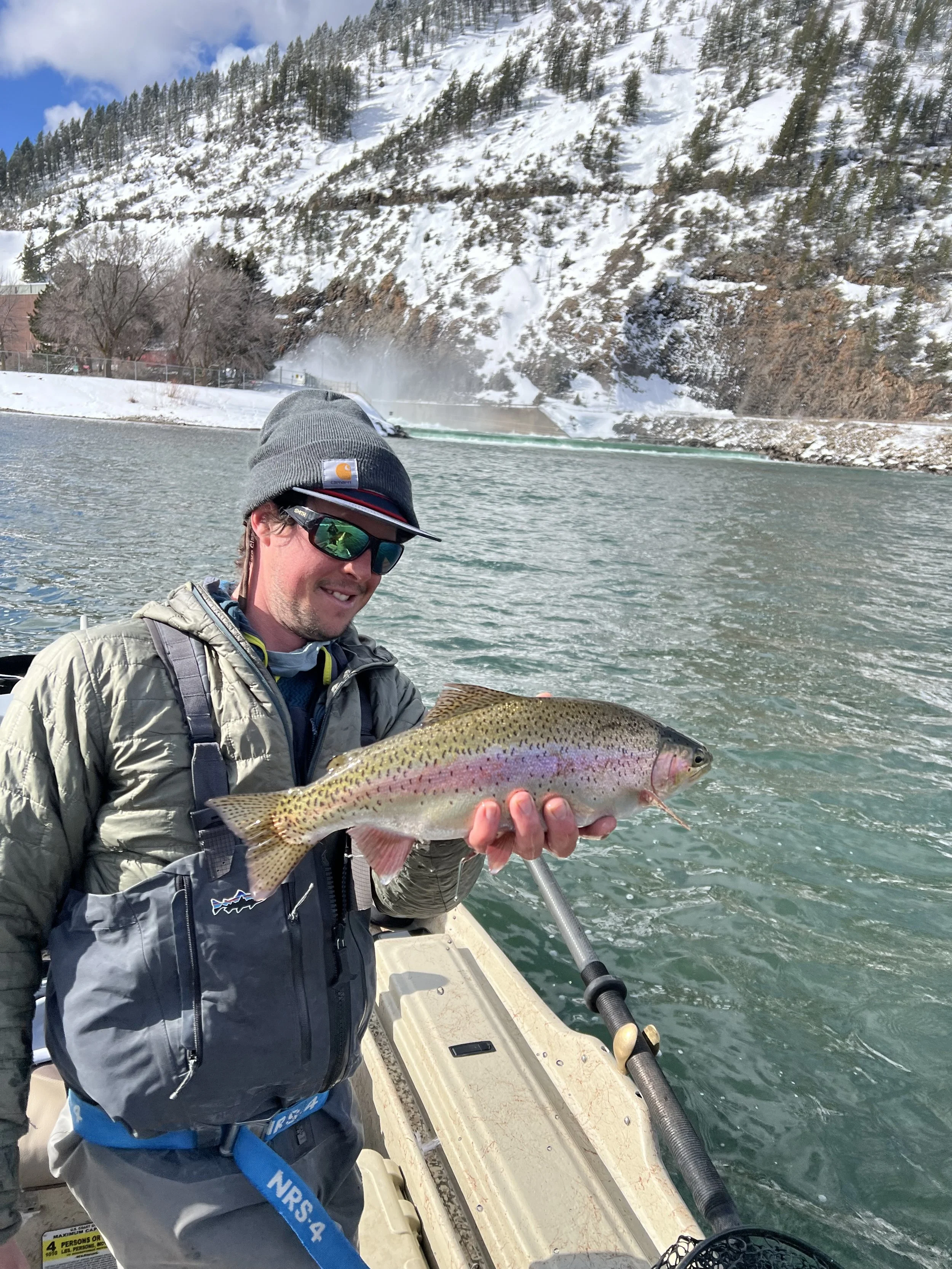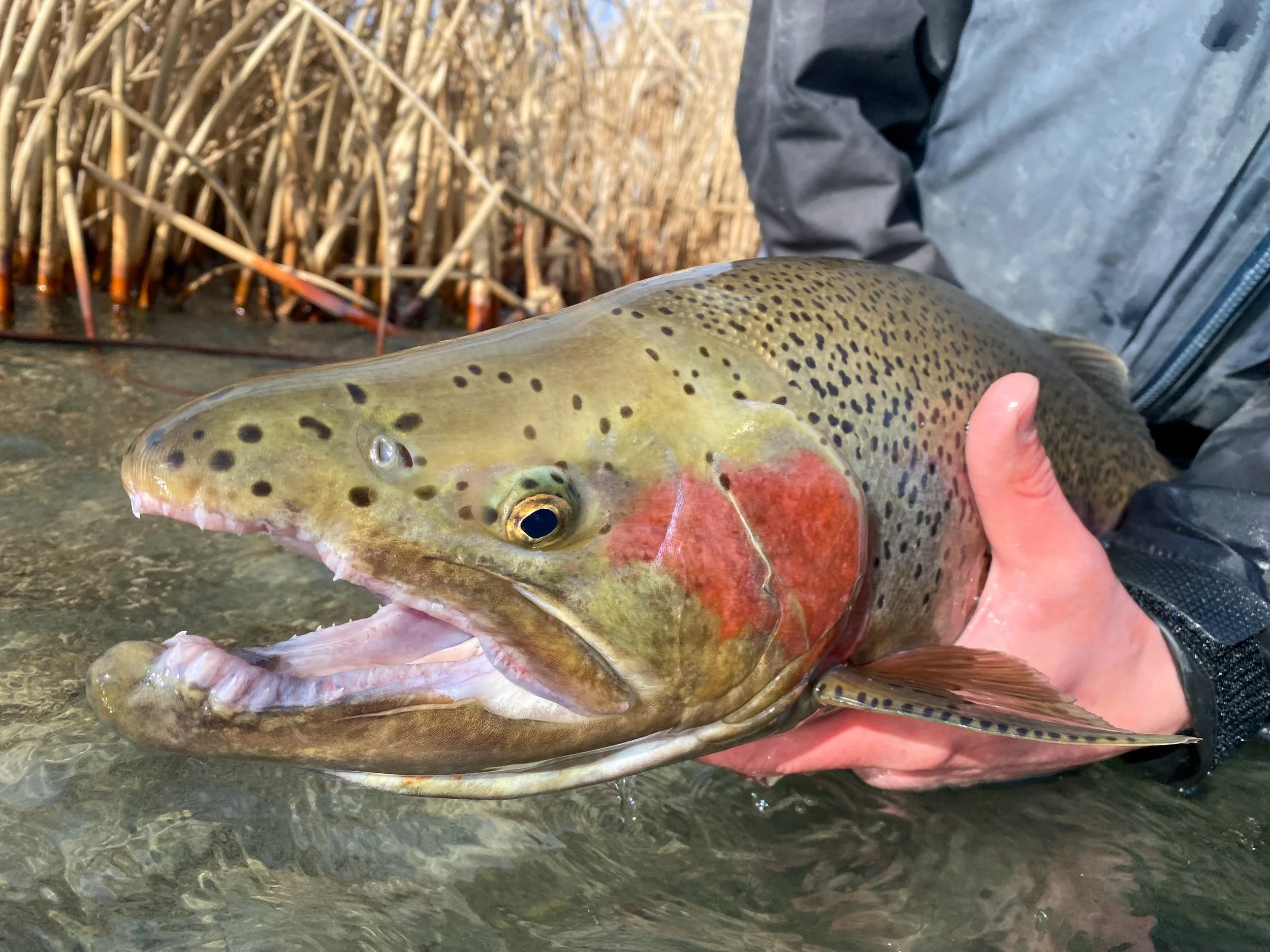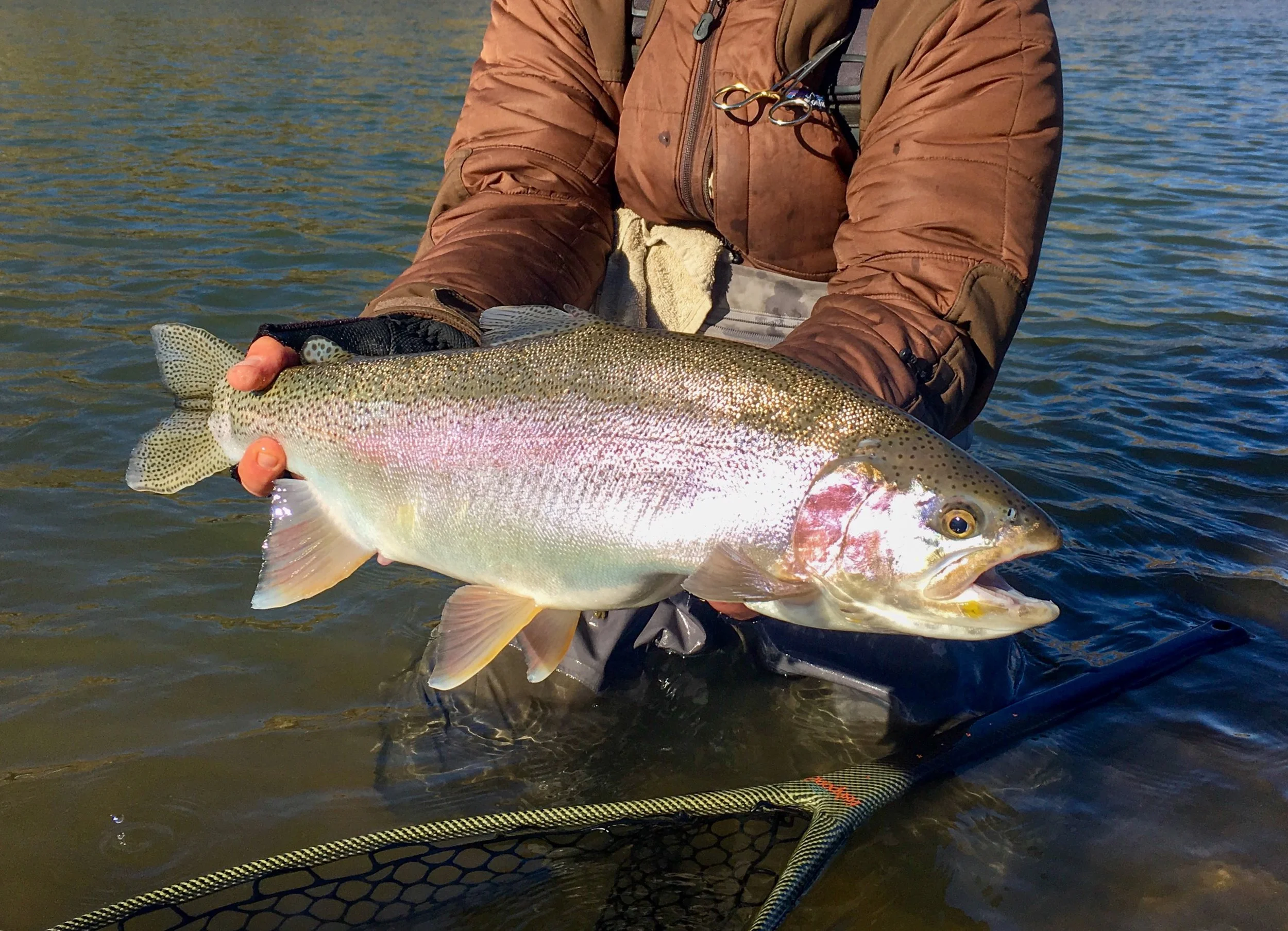Winter Techniques South Fork
First guided trip of 2024 South fork of the snake river
Winter trout fishing isn’t for everyone, but for the few fly fishing enthusiasts, what I call “addicts,” It's the season we look forward to getting us through until spring appears. Living in Jackson Hole since 2011, I've concluded that the fly fishing opportunities here are endless year-round. Jackson Hole is a unique area for our national parks' world-class skiing, and it is where Jackson is located. It might not be the best place to chase trophy-sized brown and rainbow trout, but where Jackson is located allows you to access many different fisheries within a 1-3hr drive where trophy trout can thrive. Winter is a great time to check a few of these areas out. I prefer to fish tailwater rivers during the colder winter months of December, January, and February. Tailwater dams create consistent water temperatures through the winter months. As Brown trout finish up their spawn in early December, the Brown trout, especially the larger males, will hang out in winter runs close to the areas that they spawned in till spring. Cold Water temperatures put the fish in a lethargic stage with brief moments of eating during the warmest parts of the day. Midges and other small baitfish are the only available prey this time of year.
Winter fishing the south fork of the Snake River is a unique experience because the river feels empty compared to the traffic it tends to attract during the spring/summer/fall months. Flows average 900 cfs through the winter months, allowing plenty of wading access to winter runs or pools. The two main techniques I would stick to would be nymphing and streamer fishing, but keep your eyes peeled for the sneaky rising fish at the edges of small shallow water adjacent to slower wintering holes.
Timing and temperature.
Timing and temperature are our two significant factors. Since winter mornings can be pretty brisk, I don’t recommend wetting a line before 10am, allowing the ambient air temperature to warm up, which will reflect in the water warming up and bug life to emerge. I recommend you fish till 5:30-6:00pm; this will allow you to fish through the warmer water temperatures and a shift to low light. You will most likely see the bigger fish of the day in the 3pm-dark time window. This also allows you to witness one of our winter sunsets from the river, which can be breathtaking.
Fishing pre-storm fronts and moon phase
29 1/2” Rainbow caught February 11th 2022
Over the past +10 years of winter fishing throughout the West, I've come to a few conclusions or personal theories on fishing. Storm fronts, especially storm fronts with dramatic drops in pressure. Now, this is something you should pay attention to. I have notes and photos to prove this theory. Over the past few years of studying the weather patterns of eastern Idaho, I've noticed a few key things you're looking to have happen in the weather patterns. Warm weeks of high pressure leading into the storm front seem to be the key to success; you want to focus on fishing the few hours before the barometer drops and as it drops. My largest trout I personally caught in Idaho was February 11th, streamer fishing on a pre-storm front day. We started around 10:30. The temperature was roughly 28 degrees, and the barometer drop was scheduled to start, luckily around 2pm. This day, I was able to land 4 Hybrids between 26” and 29 1/2” in 4 hours. I can’t help but look into the key factors that explain why we're so successful: we were there the right day at the right time. But that is a simple and old way to look at it. I concluded that there were multiple key factors, one being the pre-storm front and another being the 2 points the barometer dropped between 2pm and 5pm. We also had cloudy skies, keeping the ambient air temperature rising as the pressure dropped. Another key factor was February, which is the month of staging rainbows, or what we consider the “pre-spawn bite,” they are trying to support themselves as they prepare for the spawn starting around mid-May.
Personally, I think moon phases are important to understand if you're trying to trophy hunt. Trophy trout, as they grow, become sensitive to light. Sunlight or moonlight can factor in how spooky the fish will be. During the winter, I like a half-moon phase or less due to the low water and reflective snow on the banks. Summer months are similar. I usually have better fishing during the half-moon phase through most of the year.
How I approach winter holes and runs
Well, there are a few different ways to approach winter fishing. I've noticed this works best. I like to approach the run from downstream, walking up towards the head of the run. I usually take a wide birth around the winter run in hopes of not spooking the fish cruising the inside nonmoving water or what I call the “pond.” Fish circling the pond are doing one of two things: searching for emerging midges, sometimes on the surface, or being lethargic. These fish can be hard to connect with; you will see them circling a perimeter and getting into a feeding pattern. These fish are not the easiest to catch due to the size and amount of food and their unpredictable behavior from left to right up and down. Remember, it's still worth chasing, though the challenge is the fun part. As you approach the top end of the run, pay close attention to the soft inside water on the edge of the riffles. It’s worth watching these areas to see if anything appears. The fish on the edges of riffles and shevels are more straightforward to approach. Most Likely, their head is facing upstream into the current, away from you. Also, fish don’t have the time to “ investigate the fly” like the fish sitting in the “pond” areas. Take time to pick off the fish closest to you in the run—allowing you not to spook other fish further out.
Over the years of guiding fishing winter trips, I've noticed that a short cast is better, especially with nymphing rigs. I would consistently tell people not to cast too far. The productive water is the water that is barely moving and even sometimes feels stagnant. Believe it or not, this is where they all winter, allowing them to go from a lethargic stage to a feeding stage without changing positions in the run. They will most likely change positions in depth instead of location. What I mean by this is fish will most likely start to suspend instead of moving up or down in the run. When hatches become pretty thick, you see fish change location toward the head of the run, where the food is drifting down from. This is when fishing gets excellent when trout start to compete in the head of the run.
“Deep and Heavy is a myth.”
It’s funny how, at the start of our fly fishing careers, we look down into the deep holes and wonder how big a brown trout might live down there. We tie on the heaviest streamer or nymph with gobs of weight to get deep enough. Yes, I've been in that stage before. But over the past few years of reading articles published online and researching, I've noticed that anything more profound than 7ft in depth doesn’t hold fish either. This has to be due to the minimal amount of sunlight affecting the water temperature and bug life. Another way to look at it is that water surface temperatures are usually warmer than water temps at 6 feet or deeper. Feeding fish will move into the warmer water to feed, making it easier for them to feed and conserve calories productively. In the winter, I set up my nymph rigs from 9ft-14ft in length. “ I thought you said to stay in the top 6ft ?” Yes, I did say that, but I have a reason for the length. Winter fish can be spooky, with clear water and low flows of gin. I use the length of stealth, sometimes adding 2-3ft between flies. This might sound not easy, but it can become simple once you understand it. There are two ways to set up your nymph rig. One is “long and Light,” and another is “short and heavy. The first question you will ask is, “Where and when,” Which rig should I throw? Well, you have to look where you’re fishing. If you are fishing fast, pocket water is slow, almost stagnant, or shallow riffles.
+6lb rainbow trout on #18 midge
When to use long and light nymph rigs
Long and light, it is one of my favorite nymph rigs to have clients fish; this rig allows you to fish 1-4ft of water with great success. My long and light rigs start at around 10ft and range up to 14ft. Yes, it’s a lot of leaders, but it works. With this rig, I will have clients fish the slow insides, shallow riffles, and slow tailouts. The reason it's so successful in these areas is that your flies slowly fall in-depth, allowing you a longer time between touching or catching the bottom. This also allows your flies ample time in the strike zone if fish are suspended off the bottom. Continually change depths: most folks set their depth with their indicator at the boat ramp and never change depths once. I have those days when it seems like depth doesn’t matter; fish are just on the chew. But most days, I'm saying 90% of my days, I'm continuously changing depth as we approach new runs, tail outs, and shelves.
Short and heavy
While I prefer when the “light and long” rigs, short and heavy has its time and place, that’s for sure. Pocket water boils, and heavy water over sharp shelves are three things you should look for when setting up a “short and heavy rig.” Short and heavy is best when quickly getting your fly to a certain depth. Tungsten Jigs and tungsten weighted flies work best when fish are willing to eat flys with weighted beads on them. If you notice while you're fishing throughout the day that the trout seems to be holding at a specific depth and location in the run. This is where short and heavy can thrive. With the brief and heavy rig, your flies will be at a peak depth almost immediately, depending on the speed and volume of water you're fishing. This allows you to dial in the depth and understand where your flys might be in the run. Remember, your flies are heavy. They most likely will lag behind your indicator.
Preferred Indicators
Honestly, there are a few options; the options I like the most are apparent, hold up a decent amount of weight, are sensitive, and leave a minimal impression on the water. Oros are great because they're simple to use and easily adjustable. Yarn indicators are also significant, especially the New Zealand strike indicators, which are very sensitive and leave minimal impressions but can be a pain when winter fishing as they absorb some water and can freeze. An excellent guide on the Big Horn River and great friend Neil Strickland introduced me to using balloons as indicators. This changed my nymphing game tremendously, and I could not be more thankful to be willing to share this gem of a technique. The great thing about the balloon is that it is light in weight, leaving a minimal impression on the water; it also comes in endless colors, making it easy to see. You can adjust the balloons in size, making them friendly for impaired vision to see and hold up heavy-weight flies.
Short leasing
We have gone through the “nymph rigs,” which are pretty complicated compared to the dry fly and streamer rigs. But let's talk about another deadly technique, “short leasing.” short leasing is a technique where you take a small dry fly like a size #14 or #16 Adams or other higher floating dry fly; I've even used tiny foam ants for this tying in a. Section 6” to 10” long to a small midge nymph or emerger. You will be surprised sometimes when you see a trout eat an ant in the middle of the winter, but you will! This technique is excellent for working pods of rising trout with decent winter angling pressure. This allows your eyes to relax and not fixate on the small drys that become invisible when cast, also allowing you to work the top 8” of the water column where midges are collecting in the current lines. Try this technique if you are fishing for a rising fish that won’t eat.
Dry fly rigs
cutthroat trout on midge dry flys
I think this is one of the easier ones to tie up. I usually keep the dry fly leader around 10ft of 4x or 5x, depending on how much sun is forecasted for the day. On sunny days, I use 5x cloudy days and 4x. When fishing tiny midges between the sizes of #16 and #20, instead of tying in the second fly by adding a clinch knot to the bend of the hook, I use the tag of the 4x or 5x I tied in with a blood knot each fly can float independently allowing better hook up and less of a chance of straightening your hooks.
Winter streamer rigs
24” winter rainbow trout
Winter streamer rigs are about as simple as they get. 6ft-7ft leader 12lb fluorocarbon to a 200-grain sink tip line. It’s all about moving it slowly and effectively. Winter is a great time to swing streamers. With the cold water temperatures, fish will not chase your fly very far, if not at all. Swinging the fly allows you time for a larger trout to gain interest and bite. When I get the chance to winter fish, I usually start with a streamer working the entire winter run from top to bottom; if I have no luck, I will change my fly on size, weight, and color. In that order, continue the process. If that doesn’t work, I will usually nymph or dry fly fish if the option is available, then go back to streamer fishing to see if anything has changed.




